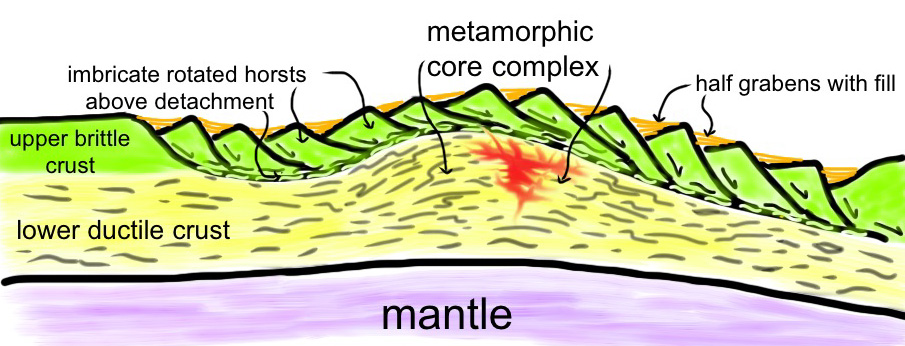
Metamorphic core complexes
Ancillary page for Plate Tectonics GEOL 3300, University of Nebraska at Omaha
Instructor: Harmon Maher
Description
A metamorphic core complex is a structural/tectonic association, a suite of features commonly found together. While quite diverse they typically include the following arranged in an antiformal feature (listed from top to bottom):

'Cartoon' depiction of metamorphic core complex. This diagram could be improved in several ways, one of which is that the imbricate rotated fault blocks can move so far that the half graben fill is in direct contact with the detachment.
Genesis and significance
A question that leads to insight as to the nature of core complexes is – where did all the middle crustal rocks go? Where are the low and medium grade rocks that should be between high grade metamorphic rocks and overlying sedimentary rocks? Rocks from the uppermost part of the crust are sitting on top of (although in fault contact with) rocks of the lower crust. Core complexes are thus characterized by crustal omission and/or attenuation. The answer is that hyper-extension along a shallowly dipping detachment surface has slid the shallow upper plate rocks off their crustal underpinnings and moved them until they are next to the lower crust. In some extreme examples, the flake of crust in the upper plate has moved so far that mantle has been exposed. The lower plate rocks will experience tectonic denudation as the upper plate rocks slide off, causing the retrograde history.
In a way understanding metamorphic core complexes was a continuation of a revolution in tectonics (and structural geology) where earlier on thick-skinned deformation dominated, but with time the common occurrence of thin-skinned tectonics with shallowly dipping detachments was recognized. Metamorphic core complexes with their upper and lower plates separated by a detachment are an expression of thin-skinned tectonics. There has been substantial debate about the mechanical possibility of very low-angle normal faults and detachments (Collettini, 2011). In addition there is debate about the nature of deformation in the lower crustal rocks and what contributes to forming the antiform. Isostasy clearly plays some role as the tectonic denudation of thin-skinned hyperextension is a significant crustal unloading, triggering uplift and doming. There is an older concept of, and associated literature on, gneiss domes that connects to that on metamorphic core complexes. To make things a bit more challenging in some cases the detachment surface is corrugated, with the antiformal axes sub-parallel to the direction of movement. There is still a lot to understand about these tectonic features. Platt et al. (2015) provide a more recent review.
Some examples
The Basin and Range is an area of significant continental extension, and so it is perhaps not surprising that metamorphic core complexes are found here (Gordon & Lister 1989). In some ways the Basin and Range is where core complexes were first recognized for what they are. One of the more famous detachments is the Whipple fault.

1994 map of Basin and Range core complexes (black blobs) within the Basin and Range province (stippled pattern) from USGS field trip guide – retrieved 8/15/18 from https://pubs.usgs.gov/of/1994/0246/report.pdf. The brick pattern represents the Colorado plateau.

Image of sub-horizontal detachment and overlying upper plate rocks in northern Nevada. Image retrieved from the USGS site on 8/7/18: https://pubs.usgs.gov/sir/2007/5261/figure7.html

The Norwegian, Greenland and Svalbard Caledonides also show metamorphic core complexes that developed at the tail end of Ordovician-Silurian Caledonian crustal thickening and metamorphism and afterwards (e.g. Braathen et al. 2000 & 2017, Fossen 2010) during the Late Silurian and Devonian. They help make the case for a connection between core complexes and orogenic extensional collapse (more on orogenic collapse later).
Images from a core complex in northwestern Spitsbergen (Braathen et al. 2017) illustrating some of the various components. Central photo is view of part of the detachment looking to the southeast. Upper plate and detachment zone rocks moved to the north (obliquely to viewer's left) relative to the underlying rocks. Wilhelmtinden is > 700 m high.
Fairly young core complexes have also been mapped in the eastern Mediterranean area (e.g. Thompson et al. 2009). These occur in a very different tectonic setting than the above two examples, and represent extension associated with subduction and in the overriding plate. An active metamorphic core complex is proposed to exist in Papua New Guinea area (Daczko et al. 2011), and is also likely linked to subduction processes. When we discuss subduction processes in more detail later on in the course one mechanism contributing to such hyper-extension and core complex development will be introduced.
Oceanic core complexes
Early dredging of the ocean floor brought up ultramafic rocks in addition to the abundant basalts. These could be explained as part of a differentiated magma chamber, perhaps exposed along transform faults. However, it turns out there are ‘bare’ spots where there is no oceanic crust and the mantle is exposed at the sea bottom because the overlying oceanic crust has slid off and not formed. Subsequent research demonstrates these are bounded by low-angle fault surfaces, often corrugated, and are core complexes in oceanic crust. Turns out it might be easier to drill to the mantle than one thought.

Bathymetry and interpretation of oceanic core complex along the Mid-Atlantic ridge (23° N). Note that the corrugations are parallel to the spreading direction. Image from the NOAA site https://oceanexplorer.noaa.gov/okeanos/explorations/ex1104/background/tectonic/media/tectonic4_kane_occ.html (retrieved 8/7/18)
Mike Cheadle, University of Wyoming, YouTube lecture on oceanic core complexes at the USGS - https://www.youtube.com/watch?v=sGDqbasw19I
References